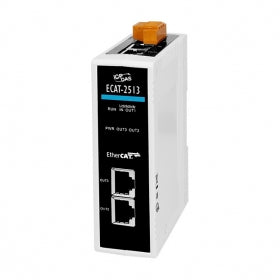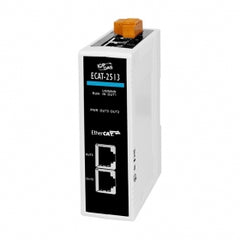

ECAT-2513 EtherCAT 4-port Junction Slave Module
- £161.00
- £161.00
- (-0%)
- Unit price
- per
EtherCAT 4-port Junction Slave module
Subtotal:
£161.00
Couldn't load pickup availability
Free Shipping
Free standard shipping on orders over £500
Free Returns
30 Day Money Back Guarantee
Description
xECAT-2513 is 4-port EtherCAT junction slave. They are designed for realising flexible wiring by daisy chain and branch. The ECAT-2513 cannot be used as a standard Ethernet switch.
Features
x- Powerful MCU handles efficient network traffic
- Distance between Stations up to 100 m (100BASE-TX)
- Support daisy chain and star connection
- EtherCAT conformance test tool verified
- ESD Protection 4 KV Contact for each port
Specifications
x| EtherCAT | |
|---|---|
| Ports | 4 x RJ-45 (1 IN; 3-OUT) |
| No. of Nodes | 2 |
| Distance Between Stations | Max. 100 m (100BASE-TX) |
| Power | |
|---|---|
| Reverse Polarity Protection | Yes |
| Input Range | +10 ~ +30 VDC |
| Consumption | 0.06 A @ 24 VDC |
| Mechanical | |
|---|---|
| Casing | Plastic |
| Dimensions (mm) | 33 x 127 x 90 (W x L x H) |
| Installation | DIN-Rail |
| Environment | |
|---|---|
| Operating Temperature | -25 ~ + 75 °C |
| Storage Temperature | -30 ~ + 80 °C |
| Humidity | 10 ~ 90% RH, non-condensing |
Applications
x Benefit 1: Translate Daisy-chain to Branch Topology
EtherCAT junction slaves can implement wiring in branch topology. The wiring of branch topology is easier than daisy-chain topology.
Benefit 2: Improve the Debugging Efficiency
For daisy-chain topology, if a slave device is not working or the cable is disconnected, all slave devices in the same network will not be able to communicate with the master controller.
With EtherCAT junction slaves, all slave devices can be wired as separated sections. If one slave device is failed, only the slave devices in the same section will be affected. With the help of EtherCAT junction slave module, the slave devices in other sections still can communicate with the master controller. Debugging can be done separately, thus improving the debugging efficiency.
Related Products
Example product title
- £161.00
- £161.00
- (-0%)
- Unit price
- per
Example product title
- £161.00
- £161.00
- (-0%)
- Unit price
- per
Example product title
- £161.00
- £161.00
- (-0%)
- Unit price
- per
Example product title
- £161.00
- £161.00
- (-0%)
- Unit price
- per
Example product title
- £161.00
- £161.00
- (-0%)
- Unit price
- per
Example product title
- £161.00
- £161.00
- (-0%)
- Unit price
- per
Example product title
- £161.00
- £161.00
- (-0%)
- Unit price
- per
Example product title
- £161.00
- £161.00
- (-0%)
- Unit price
- per
Example product title
- £161.00
- £161.00
- (-0%)
- Unit price
- per
Example product title
- £161.00
- £161.00
- (-0%)
- Unit price
- per
Recently Viewed Products
Example product title
- £161.00
- £161.00
- (-0%)
- Unit price
- per
Example product title
- £161.00
- £161.00
- (-0%)
- Unit price
- per
Example product title
- £161.00
- £161.00
- (-0%)
- Unit price
- per
Example product title
- £161.00
- £161.00
- (-0%)
- Unit price
- per
Example product title
- £161.00
- £161.00
- (-0%)
- Unit price
- per
Example product title
- £161.00
- £161.00
- (-0%)
- Unit price
- per
Example product title
- £161.00
- £161.00
- (-0%)
- Unit price
- per
Example product title
- £161.00
- £161.00
- (-0%)
- Unit price
- per
Example product title
- £161.00
- £161.00
- (-0%)
- Unit price
- per
Example product title
- £161.00
- £161.00
- (-0%)
- Unit price
- per
- Choosing a selection results in a full page refresh.

